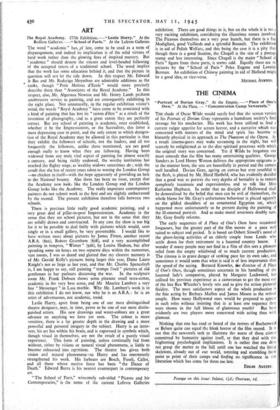The Royal Academy. 177th Exhibition. "Leslie Hurry." At the
ART
Redfern Galleries.—" School of Paris." At the Lefevre Galleries The word " academic " has, pf late, come to be used as a term of disparagement, and indeed its implication is of the solid virtues of hard work rather than the glowing fires of inspired mastery. But " academic " should denote the sincere and level-headed following bf the accepted tenets of a traditional school. The word implies that the work has some education behind it, and that the picture in question will not let the side down. In this respect Mr. Edward le Bas and Mr. Roderigo Moynihan are admirable additions to the ranks, though " Petit Maitrcs d'Ecole " would more precisely describe them than " Associates of the Royal Academy." In this respect, also, Mr. Algernon Newton and Mr. Henry Lamb perform unobtrusive service to painting, and are consequently exhibiting in she right place. Not unnaturally, in the regular exhibition visitor's mind, the words " Royal Academy " have come to be associated with a kind of painting that has lost its " raison d'etre " as a result of the invention of photography, and to a great extent they are perfectly correct. But any school of painting is academic, once established, whether it be the Impressionists, or the Surrealists, this latter a most depressing case in point, and the only extent to which denigra- tion of the Royal Academy may be allowed in this particular is that they exhibit the followers of schools, not the leaders, and all too frequently the followers, unlike those mentioned, are not good enough really to know what they are following. Having • been widowed from any truly vital aspect of painting for almost exactly a century, and being richly endowed, the worthy institution has reached the flighty stage, as 'wealthy widows sometimes do ; with the result that she has of recent years taken to wooing the London Group —no chicken in itself—with the hope apparently of providing an heir to the National bounty. Alas there has been no issue, except that the Academy now look; like the London Group and the London Group looks like the Academy. The really important contemporary painters do not submit work to the first and are slightly embarrassed by the second. The present exhibition therefore falls between two schools.
There is precious little really good academic painting, and a very great deal of pillar-to-post Impressionism. Academic in the sense that they are school pictures, but not in the sense that they are solidly drawn and constructed. In any.case the show is too big for it to be possible to deal fairly with, pictures which would, seen singly or in a small gallery, be very presentable. I would like to have written more about pictures by. James Fitton, another recent A.R.A. (602), Robert Greenham (628), and a very accomplished painting in tempera, " Winter " (926), by Louisa Hodson, but after spending some six hours on two separate days within the numerous, vast rooms, I was so dazed and glutted that my clearest memory is of Mr. Gerald Kelly's pictures being larger this year, Dame Laura Knight's not so large as last year, and that Mr. Charles Spencelayh is, I am happy to say, still painting " trompe l'oeil " pictures of old
gentlemen in bar parlours discussing the war. In the sculpture room Mr. Frank Dobson shows some pleasant small terra-cottas, academic in the very best sense, and Mr. Maurice Lambert a very fine " Messenger " in Lasa marble. Why Mr. Lambert's work is in this exhibition I do not know, nor why he is an A.R.A.: he is an artist of adventurous, not academic, trend. .
Leslie Hurry, apart from being one of our most distinguished theatre designers, may, in time, prove to be one of our most distin- guished artists. His new drawings and water-colburs are a great advance on anything we have yet seen. The colour is more sensitive, there is a far greater depth in the drawing and a more powerful and personal imagery in the subject. Hurry is an intro- vert, his art lies within his brain, and is expressed in symbols which, though visual in themselves, are not the result of a purely visual experience. This form of painting, unless continually fed from without, either by visions or natural visual phenomena, is liable to become exhausted into repetition: The theatre has given both vision and natural phenomena-a:to Hurry and has enormously strengthened his work. His forbears are Bosch, Fuseli, Callot, and all those whose motive force has been " the Dance of Death." Edward Burra is his nearest counterpart in contemporary art.
"The School of Paris," winsomely sub-titled " Picasso and his Contemporaries," is the name of the current Lefevre Galleries
exhibition. There are good things in it, but on the whole it is not a very exciting exhibition, considering the illustrious names involved. The Picassos themselves are a very poor bunch, but there is a fine Modigliani, good Vuillards and a splendid Rouault. The exhibition is in aid of Polish Welfare, and this being the case it is a pity that, though there is a good Soutine, the Chagall is the size of a postage stamp and less interesting. Since Chagall is the major " School of Paris " figure from those parts, it seems odd. Equally there are no pictures by the " School of Paris " Poles Eugene and Leonide Berman. An exhibition of Chinese painting in aid of Holland might be a good idea, or vice-versa. • MICHAEL Avandsi.






















 Previous page
Previous page